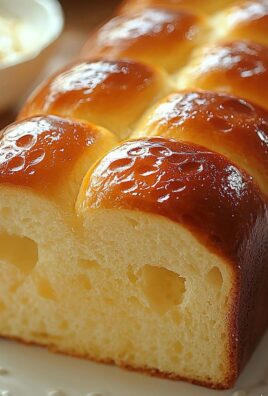Breakfast Cheese Danish: the mere mention of it conjures images of flaky, golden pastry, a creamy, sweet filling, and the promise of a delightful start to your day. Have you ever wondered about the origins of this beloved treat? While often associated with Denmark, its roots actually trace back to Austria! Bakers brought their techniques to Denmark, where they were adapted and perfected, eventually becoming the iconic pastry we know and love today.
What is it about a Breakfast Cheese Danish that makes it so irresistible? Perhaps it’s the contrasting textures – the crisp, buttery layers of the dough giving way to the smooth, rich cheese filling. Or maybe it’s the perfect balance of sweet and tangy flavors that dance on your palate. Whatever the reason, this pastry has earned its place as a breakfast staple and a delightful indulgence any time of day. I find that the aroma alone is enough to brighten my morning!
In this recipe, I’ll guide you through creating your own homemade Breakfast Cheese Danishes. Don’t be intimidated! While they may seem complex, with a few simple steps and readily available ingredients, you can easily recreate this bakery favorite in your own kitchen. Get ready to impress your family and friends with these delectable treats. Let’s get baking!

Ingredients:
- For the Dough:
- 1 cup warm milk (105-115°F)
- 2 ¼ teaspoons (1 packet) active dry yeast
- ¼ cup granulated sugar
- 1 teaspoon salt
- 2 large eggs, lightly beaten
- ¼ cup (½ stick) unsalted butter, melted and cooled
- 3 ½ – 4 cups all-purpose flour, plus more for dusting
- For the Cheese Filling:
- 8 ounces cream cheese, softened
- ½ cup granulated sugar
- 1 large egg yolk
- 1 teaspoon vanilla extract
- 1 tablespoon lemon zest
- For the Butter Layer:
- 1 cup (2 sticks) unsalted butter, very cold
- ½ cup all-purpose flour
- For the Egg Wash:
- 1 large egg, beaten
- 1 tablespoon milk
- For the Glaze (Optional):
- 1 cup powdered sugar
- 2-3 tablespoons milk
- ½ teaspoon vanilla extract
Preparing the Dough:
- Activate the Yeast: In a large bowl (or the bowl of your stand mixer), combine the warm milk, yeast, and sugar. Let it sit for 5-10 minutes, or until the yeast is foamy. This step ensures that your yeast is alive and active, which is crucial for a good rise. If it doesn’t foam, your yeast might be old, and you’ll need to start over with fresh yeast.
- Combine Wet Ingredients: Add the salt, beaten eggs, and melted butter to the yeast mixture. Stir well to combine. Make sure the butter is cooled slightly so it doesn’t cook the eggs.
- Add Flour Gradually: Gradually add the flour, one cup at a time, mixing well after each addition. If using a stand mixer, use the dough hook attachment. Start with 3 ½ cups of flour. You may need to add more, depending on the humidity and the type of flour you’re using. The dough should be slightly sticky but not overly wet.
- Knead the Dough: Turn the dough out onto a lightly floured surface and knead for 5-7 minutes, or until it becomes smooth and elastic. If using a stand mixer, knead with the dough hook for 5-7 minutes on medium speed. The dough should pass the windowpane test – meaning you can stretch a small piece of dough thin enough to see light through it without tearing.
- First Rise: Place the dough in a lightly oiled bowl, turning to coat. Cover with plastic wrap or a clean kitchen towel and let it rise in a warm place for 1-1.5 hours, or until doubled in size. This first rise is essential for developing the flavor and texture of the dough.
Preparing the Butter Layer:
- Combine Butter and Flour: While the dough is rising, prepare the butter layer. In a medium bowl, combine the very cold butter (cut into small cubes) and the flour.
- Mix the Butter and Flour: Use a pastry blender or your fingertips to cut the butter into the flour until the mixture resembles coarse crumbs. The key here is to keep the butter cold. If it gets too warm, it will melt and the butter layer won’t work properly. You want small pieces of butter distributed throughout the flour.
- Form a Rectangle: Gather the butter-flour mixture into a ball, flatten it slightly, wrap it in plastic wrap, and shape it into a rectangle about 6×8 inches. Refrigerate for at least 30 minutes. This chilling step is crucial to keep the butter solid.
Preparing the Cheese Filling:
- Cream the Cheese: In a medium bowl, beat the softened cream cheese with an electric mixer until smooth and creamy. Make sure your cream cheese is truly softened; otherwise, you’ll end up with lumps in your filling.
- Add Sugar and Egg Yolk: Add the sugar and egg yolk to the cream cheese and beat until well combined. The egg yolk adds richness and helps bind the filling together.
- Add Vanilla and Lemon Zest: Stir in the vanilla extract and lemon zest. The lemon zest adds a bright, citrusy flavor that complements the cream cheese beautifully.
- Refrigerate: Cover the cheese filling and refrigerate until ready to use. This helps the filling firm up and makes it easier to work with.
Assembling the Danish:
- Roll Out the Dough: Once the dough has doubled in size, punch it down gently to release the air. Turn it out onto a lightly floured surface and roll it into a large rectangle, about 12×18 inches.
- Place the Butter Layer: Place the chilled butter rectangle in the center of the dough rectangle. Fold one side of the dough over the butter, and then fold the other side over, like you’re folding a letter. This creates layers of dough and butter, which will result in a flaky pastry.
- First Turn: Gently roll the dough into a rectangle again, about 12×18 inches. Fold the dough into thirds, like you’re folding a letter. This is called a “turn.” Wrap the dough in plastic wrap and refrigerate for 30 minutes.
- Second Turn: Repeat the rolling and folding process (another “turn”). Roll the dough into a rectangle, fold it into thirds, wrap it in plastic wrap, and refrigerate for another 30 minutes.
- Third Turn: Repeat the rolling and folding process one more time (a third “turn”). Roll the dough into a rectangle, fold it into thirds, wrap it in plastic wrap, and refrigerate for a final 30 minutes. These turns are what create the flaky layers in the Danish. Don’t skip them!
- Shape the Danish: After the final chilling, roll the dough into a rectangle about 12×18 inches. Cut the dough into 12 equal squares.
- Add the Filling: Place a spoonful of the cheese filling in the center of each square.
- Fold the Corners: Fold two opposite corners of each square towards the center, overlapping slightly. Press gently to seal. You can also get creative with the shaping – try folding all four corners to the center, or cutting slits in the sides and folding them towards the center.
- Second Rise: Place the shaped Danish pastries on a baking sheet lined with parchment paper. Cover loosely with plastic wrap and let them rise in a warm place for 30-45 minutes, or until slightly puffy.
Baking the Danish:
- Preheat Oven: Preheat your oven to 375°F (190°C).
- Prepare Egg Wash: In a small bowl, whisk together the egg and milk for the egg wash.
- Brush with Egg Wash: Brush the tops of the Danish pastries with the egg wash. This will give them a beautiful golden-brown color.
- Bake: Bake for 15-20 minutes, or until golden brown and the filling is set. Keep a close eye on them, as baking times can vary depending on your oven.
- Cool: Let the Danish pastries cool on the baking sheet for a few minutes before transferring them to a wire rack to cool completely.
Glazing (Optional):
- Prepare the Glaze: While the Danish pastries are cooling, prepare the glaze. In a small bowl, whisk together the powdered sugar, milk, and vanilla extract until smooth. Add more milk if needed to reach your desired consistency.
- Drizzle the Glaze: Drizzle the glaze over the cooled Danish pastries. You can use a spoon or a piping bag for a more precise application.
- Enjoy! Let the glaze set for a few minutes before serving. These Danish pastries are best enjoyed fresh, but they can be stored in an airtight container at room temperature for up to 2 days.

Conclusion:
This Breakfast Cheese Danish recipe isn’t just another pastry; it’s a guaranteed crowd-pleaser that brings a touch of bakery magic right into your kitchen. The flaky, golden crust, the creamy, sweet cheese filling, and that hint of bright citrus – it all comes together in a symphony of flavors and textures that will have everyone reaching for seconds (and maybe even thirds!). I truly believe this is a must-try recipe for anyone who loves a good breakfast treat or wants to impress their friends and family with their baking skills.
But what makes this Danish truly special is its versatility. While it’s absolutely divine served warm straight from the oven, it’s equally delicious at room temperature, making it perfect for brunch gatherings or a quick on-the-go breakfast. For a truly decadent experience, try serving it with a scoop of vanilla ice cream or a dollop of whipped cream. The contrast of the warm pastry and the cold creaminess is simply irresistible.
Looking for variations? The possibilities are endless! You could add a layer of your favorite fruit preserves – raspberry, apricot, or strawberry would all be fantastic choices. Or, for a more savory twist, consider adding a sprinkle of chopped nuts or a drizzle of honey. If you’re feeling adventurous, you could even incorporate a hint of almond extract into the cheese filling for a richer, more complex flavor. Another great option is to add a streusel topping for extra crunch and sweetness. Simply combine flour, butter, and sugar, and sprinkle it over the Danish before baking.
Don’t be intimidated by the thought of making your own Danish pastry. This recipe is designed to be approachable and easy to follow, even for beginner bakers. With a little patience and attention to detail, you’ll be rewarded with a truly exceptional treat that rivals anything you can find in a bakery. The aroma alone, as it bakes, is worth the effort!
I’m so confident that you’ll love this Breakfast Cheese Danish recipe that I urge you to give it a try. It’s the perfect way to start your day, impress your guests, or simply treat yourself to something special. And once you’ve mastered the basic recipe, feel free to experiment with different flavors and variations to create your own signature Danish.
I can’t wait to hear about your baking adventures! Please, share your photos and experiences in the comments below. Let me know what variations you tried, what worked well, and what you would do differently next time. Your feedback is invaluable, and it helps me to continue creating recipes that you’ll love. Happy baking, and enjoy every delicious bite! I am sure that this recipe will become a staple in your home, just as it has in mine. So, preheat that oven, gather your ingredients, and get ready to create some unforgettable memories with this incredible Danish.
Breakfast Cheese Danish: The Ultimate Guide to Baking & Enjoying
Flaky, buttery homemade cheese danishes with a creamy, tangy filling and optional sweet glaze. A delightful treat for breakfast, brunch, or dessert!
Ingredients
- 1 cup warm milk (105-115°F)
- 2 ¼ teaspoons (1 packet) active dry yeast
- ¼ cup granulated sugar
- 1 teaspoon salt
- 2 large eggs, lightly beaten
- ¼ cup (½ stick) unsalted butter, melted and cooled
- 3 ½ – 4 cups all-purpose flour, plus more for dusting
- 8 ounces cream cheese, softened
- ½ cup granulated sugar
- 1 large egg yolk
- 1 teaspoon vanilla extract
- 1 tablespoon lemon zest
- 1 cup (2 sticks) unsalted butter, very cold
- ½ cup all-purpose flour
- 1 large egg, beaten
- 1 tablespoon milk
- 1 cup powdered sugar
- 2-3 tablespoons milk
- ½ teaspoon vanilla extract
Instructions
- In a large bowl (or the bowl of your stand mixer), combine the warm milk, yeast, and sugar. Let it sit for 5-10 minutes, or until the yeast is foamy.
- Add the salt, beaten eggs, and melted butter to the yeast mixture. Stir well to combine.
- Gradually add the flour, one cup at a time, mixing well after each addition. If using a stand mixer, use the dough hook attachment. Start with 3 ½ cups of flour. You may need to add more, depending on the humidity and the type of flour you’re using. The dough should be slightly sticky but not overly wet.
- Turn the dough out onto a lightly floured surface and knead for 5-7 minutes, or until it becomes smooth and elastic. If using a stand mixer, knead with the dough hook for 5-7 minutes on medium speed.
- Place the dough in a lightly oiled bowl, turning to coat. Cover with plastic wrap or a clean kitchen towel and let it rise in a warm place for 1-1.5 hours, or until doubled in size.
- While the dough is rising, prepare the butter layer. In a medium bowl, combine the very cold butter (cut into small cubes) and the flour.
- Use a pastry blender or your fingertips to cut the butter into the flour until the mixture resembles coarse crumbs.
- Gather the butter-flour mixture into a ball, flatten it slightly, wrap it in plastic wrap, and shape it into a rectangle about 6×8 inches. Refrigerate for at least 30 minutes.
- In a medium bowl, beat the softened cream cheese with an electric mixer until smooth and creamy.
- Add the sugar and egg yolk to the cream cheese and beat until well combined.
- Stir in the vanilla extract and lemon zest.
- Cover the cheese filling and refrigerate until ready to use.
- Once the dough has doubled in size, punch it down gently to release the air. Turn it out onto a lightly floured surface and roll it into a large rectangle, about 12×18 inches.
- Place the chilled butter rectangle in the center of the dough rectangle. Fold one side of the dough over the butter, and then fold the other side over, like you’re folding a letter.
- Gently roll the dough into a rectangle again, about 12×18 inches. Fold the dough into thirds, like you’re folding a letter. Wrap the dough in plastic wrap and refrigerate for 30 minutes.
- Repeat the rolling and folding process (another “turn”). Roll the dough into a rectangle, fold it into thirds, wrap it in plastic wrap, and refrigerate for another 30 minutes.
- Repeat the rolling and folding process one more time (a third “turn”). Roll the dough into a rectangle, fold it into thirds, wrap it in plastic wrap, and refrigerate for a final 30 minutes.
- After the final chilling, roll the dough into a rectangle about 12×18 inches. Cut the dough into 12 equal squares.
- Place a spoonful of the cheese filling in the center of each square.
- Fold two opposite corners of each square towards the center, overlapping slightly. Press gently to seal.
- Place the shaped Danish pastries on a baking sheet lined with parchment paper. Cover loosely with plastic wrap and let them rise in a warm place for 30-45 minutes, or until slightly puffy.
- Preheat your oven to 375°F (190°C).
- In a small bowl, whisk together the egg and milk for the egg wash.
- Brush the tops of the Danish pastries with the egg wash.
- Bake for 15-20 minutes, or until golden brown and the filling is set.
- Let the Danish pastries cool on the baking sheet for a few minutes before transferring them to a wire rack to cool completely.
- While the Danish pastries are cooling, prepare the glaze. In a small bowl, whisk together the powdered sugar, milk, and vanilla extract until smooth. Add more milk if needed to reach your desired consistency.
- Drizzle the glaze over the cooled Danish pastries.
- Enjoy!
- Let the glaze set for a few minutes before serving.
Notes
- Make sure your yeast is fresh. If it doesn’t foam when mixed with warm milk and sugar, it’s likely expired.
- Keep the butter cold when making the butter layer. This is crucial for creating flaky layers.
- The dough should be slightly sticky but not overly wet. Adjust the amount of flour as needed.
- The chilling steps (turns) are essential for developing the flaky texture of the Danish pastries. Don’t skip them!
- Get creative with the shaping of the Danish pastries.
- These Danish pastries are best enjoyed fresh.
Printable Recipe Card
Want just the essential recipe details without scrolling through the article? Get our printable recipe card with just the ingredients and instructions.




Leave a Comment